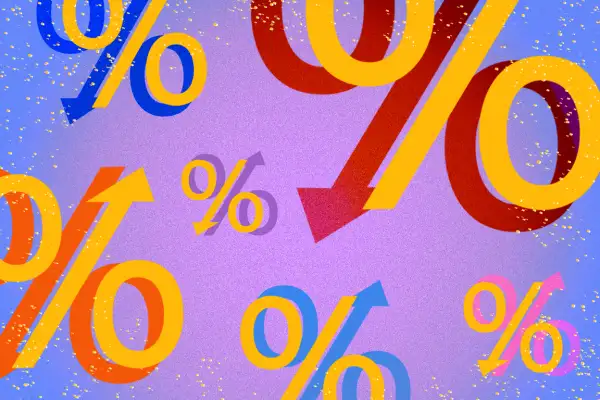4 Smart Ways to Get Ready for the Upcoming Fed Rate Cuts

Later this month, the Federal Open Market Committee is poised to cut interest rates for the first time since 2020. It's a major decision that will have consequences for tons of American consumers — so you should get ready now.
For context, the Federal Reserve has been on an absolute crusade to bring down inflation, first raising rates 11 times between March 2022 and July 2023, and then keeping them steady for about a year. High rates generally make borrowing more expensive, which ends up cooling off Americans’ spending and bringing down prices.
Now that inflation has reached 2.9% — pretty close to the Fed’s 2% long-run target, considering it peaked at 9.1% — economists are waiting for the central banking system to take action. After much debate, nearly everyone has come to agree that the Fed will likely slash the federal funds rate by 0.25 or 0.5 percentage points at its September meeting, with more cuts to come later in the year.
Here are four easy ways you may want to prepare.
1. Put your savings in the right spot
Whenever the Fed adjusts the federal funds rate, or the rate at which banks send each other money overnight, it tends to have a trickle-down effect on other interest rates. Savings rates are a prime example, according to Tim Wennes, Santander U.S. CEO.
“It's surprising the high percentage of people who haven't taken advantage of higher rates,” he says. “While it's been expensive to buy things and borrow money, this is the best time in 15 years to be saving money.”
That time, however, is about to run out. It won’t be immediate, but the ultra-high rates savers have become accustomed to are expected to gradually wane as a result of the Fed’s rate cuts.
So before they’re announced, Wennes suggests you check the annual percentage yield (or APY) on the account where you keep your savings. If it’s under 3% — and BTW, the national average is 0.46%, so this is highly possible — he suggests you seek out a higher-yield option. You can look into opening a high-yield savings account if you want to keep your cash easily accessible. If you can afford to tie up some of your money for a short period, you might want to open a certificate of deposit (CD).
Even though APYs on high-yield savings accounts will almost definitely slide as the Fed lowers rates, it's unclear how quickly or how dramatically this will happen. Because CDs, by nature, allow savers to lock in rates for a specific term — and right now those rates are higher than normal — they may be a particularly shrewd route to take.
“Those are the two key actions I would encourage consumers to make in advance of Fed rate decreases,” he adds.
2. Prepare for big purchases
Now is also a great chance to start seriously thinking about any major purchases you hope to make in the next 12 months. Santander survey data shows that Americans have been putting off buying new cars and houses because prices and borrowing costs have been so inflated lately. But as the Fed starts lowering rates, both should come down.
For mortgage rates alone, forecasts are all over the place, ranging from 5% to 6.2% at the end of 2025. Nobody knows how fast (or far) rates will fall, but preparation will be key regardless.
“Do the homework and the planning so that you can be ready, when rates do come down, [to] take advantage of the opportunity to make that purchase,” Wennes says.
You may want to work on improving your credit score, too, to make sure you're the best possible candidate for a loan when the time comes. To increase your credit score, strive to pay your bills in full and on time, and try to keep your credit utilization ratio under control.
3. Take a chill pill
Sorry to burst your bubble, but it’s not as if houses and cars will all of a sudden be super cheap on Sept. 19.
In fact, Ben Bakkum, senior investment strategist at Betterment, says not to get too caught up in the headlines.
“A lot of people have in their mind [that] it's a one-to-one relationship between the Fed’s cutting, and like, my mortgage rate is going to go down by the amount that it's cutting,” he says. “But it's going to happen on a lag, and it's going to happen over time. There's not going to be this crazy change overnight.”
4. Seek out longer maturities
This may be also be a good opportunity to seek out investment options with longer maturities, or the timeline before you recoup your investment and earnings. Bakkum says that as the federal funds rate comes down and the APYs for cash options fall, longer-term bonds may offer higher yields. By looking for bonds (and bond funds) with an extended duration now, you can lock in an attractive coupon rate — the rate of interest paid annually — for years to come.
This also helps you mitigate reinvestment risk, which is the possibility that you won’t be able to reinvest money at the same rate you previously did.
That said, younger investors saving for retirement might want to avoid stashing too much money in bonds and high-yield savings accounts at all.
Because they have a longer time horizon, they can afford to take on more risk — and keeping that money on the sidelines means they’re missing out on the “wealth-generating engine that is the stock market,” Bakkum says.
“If you're starting to re-evaluate where you're putting your money because of news like this, think about a well-diversified portfolio for the long term that includes stocks,” he adds.
More from Money:
How Low Will Interest Rates Go? Experts Predict the Fed's Upcoming Cut


